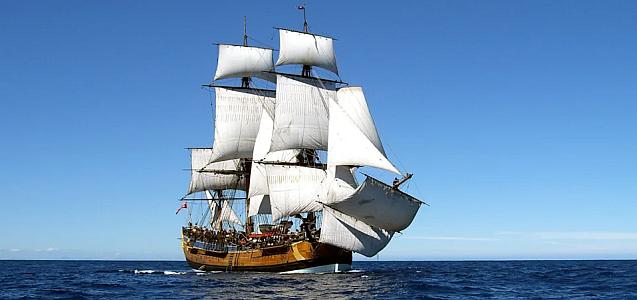
Endeavour replica image: ANMM
For more than a decade, we have followed the work of researchers from Rhode Island and Australia in their efforts to locate the wreck of Captain James Cook’s famous barque, HMB Endeavour, that sailed from 1768-1771 on a voyage of discovery to Australia and New Zealand.
Now, the Australian National Maritime Museum (ANMM)believes that its researchers have conclusively identified the wreck of the barque, in Newport, Rhode Island based on historical records and the characteristics of the much-degraded wooden hull.
The question has been not so much whether the wreck of Captain Cook’s ship Endeavour rests at the bottom of the harbor in Newport, RI, but rather which of many wrecks it may be. The Endeavour, renamed Lord Sandwich and outfitted as a troop transport, was scuttled in Newport harbor with 12 other ships in an attempt to blockade the French fleet in Narragansett Bay, Rhode Island, in 1778. The mystery has long been which of the wrecks in the harbor is the resting place of the Endeavour/Lord Sandwich.
This month, the staff of the ANMM announced that its researchers had finally found conclusive proof of the wreck’s identity, thanks to a careful analysis of its construction.
Maritime Executive reports that The researchers have discovered the wreck’s pump well, along with the keel-stem scarf joint at the bow. The location of these features lines up with the dimensions of HMB Endeavour. The pump well was drawn out in its as-built condition during a survey by the British Admiralty in 1768, before the ship began its circumnavigation, so its dimensions were known. When a map of the wreck site was overlaid over Endeavour’s lower hold plan, the pump well lined up perfectly on the plans. Since ships of this era were built to the shipwright’s own specifications by “rack of eye,” not to a preconceived plan, each individual ship was quite different – so the dimensions of the pump well would be unique to HMB Endeavour.
The scarf-joint provided further evidence, both from its location and from its design. The wreck had a rare “half-lap” scarf joint, used to build vessels with a near-vertical rake. It precisely matched Endeavour’s plans. Only a very few historical vessels are known to have been built with this joint type in this time-period, and the ones that are known are British colliers, just like Endeavour, which began its life as the collier Earl of Pembroke.
“Enough correlations have been drawn between the archaeological and historical records to identify RI 2394 as James Cook’s Endeavour and there is now an urgent need to secure the highest possible level of legislative and physical protection for the site,” the team recommended.
Thanks to Alaric Bond for contributing to this post.
